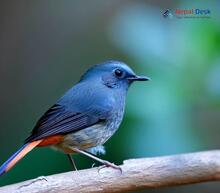The fascinating world of birds offers endless possibilities for exploration, and one particular group of birds that has captured the attention of birdwatchers worldwide is the genus Luscinia. Native to Nepal, these charming avian creatures boast a diverse range of colors, sizes, and melodious songs. This section delves into the captivating attributes of the Luscinia genus found in Nepal and provides essential information for keen birdwatchers eager to catch a glimpse of these mesmerizing birds.
Unraveling the Luscinia Genus
Belonging to the Muscicapidae family, the distinctive Luscinia genus comprises a variety of small passerine birds known for their brilliant display of colors and enchanting songs. Among the most well-known species within this genus is the Rufous-tailed robin (Luscinia sibilans), celebrated for its reddish-brown plumage and distinctive tail markings.
Exploring Nepal's Rich Bird Habitat
Nepal, a biodiverse paradise nestled amid the Himalayan Mountain Range, serves as an alluring habitat for numerous bird species, including members of the Luscinia genus. The country's diverse ecosystem – which spans from alpine meadows to subtropical forests – offers a refuge for both migratory and resident bird species.
Notable hotspots for birdwatching in Nepal include national parks like Chitwan National Park, Bardia National Park, and Shivapuri Nagarjun National Park. Additionally, Phulchowki Hill near Kathmandu provides an excellent vantage point for spotting various Luscinia species throughout the year.
Tips for Spotting Lusciniа Birds in Nepal
Patience and observation are key when attempting to spot elusive members of the Lуссinia genus. Here are a few tips to maximize your chances of successfully locating these captivating birds:
Timing: Early mornings and late afternoons are prime times for bird activity. Birds like the Luscinia species are often most vocal and visible during these periods.
Equipment: Invest in a quality pair of binoculars and study a detailed field guide to help you identify the specific bird species you may encounter.
Hire a local guide: A knowledgeable local guide can significantly increase your chances of spotting Luscinia birds, as they are well-versed in their natural habitats and behaviors.
Dress appropriately: Camouflage or neutral-colored clothing will help you blend into the environment and avoid startling the birds.
Keep quiet and still: Minimizing noise and movement will increase your chances of observing Luscinia species up close, as they can be particularly skittish.
Conclusion
The fascinating world of the Luscinia genus found in Nepal awaits birdwatchers keen to experience these enchanting avian creatures firsthand. While patience, preparation, and observation are essential components of successful birdwatching, the opportunity to witness the beauty and diversity of these birds in their natural habitat is an unrivaled reward for any nature enthusiast.




